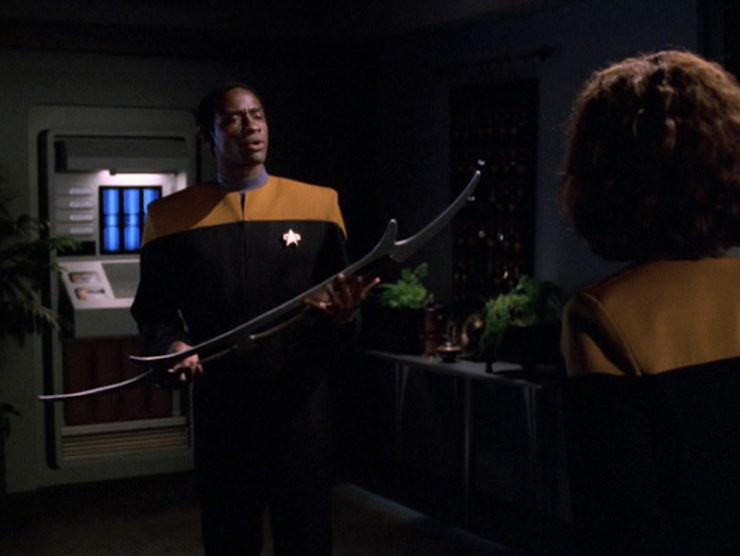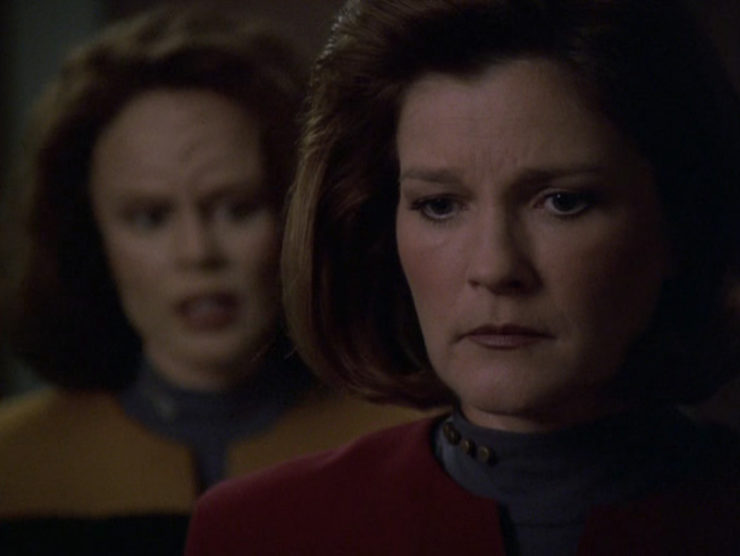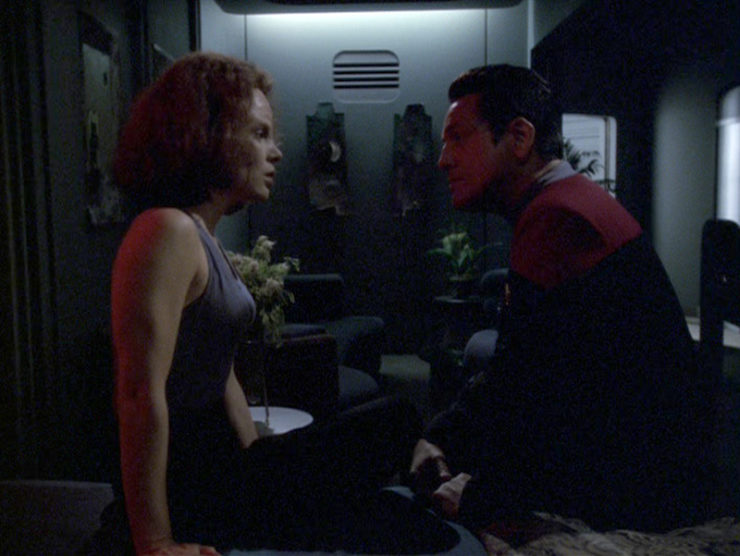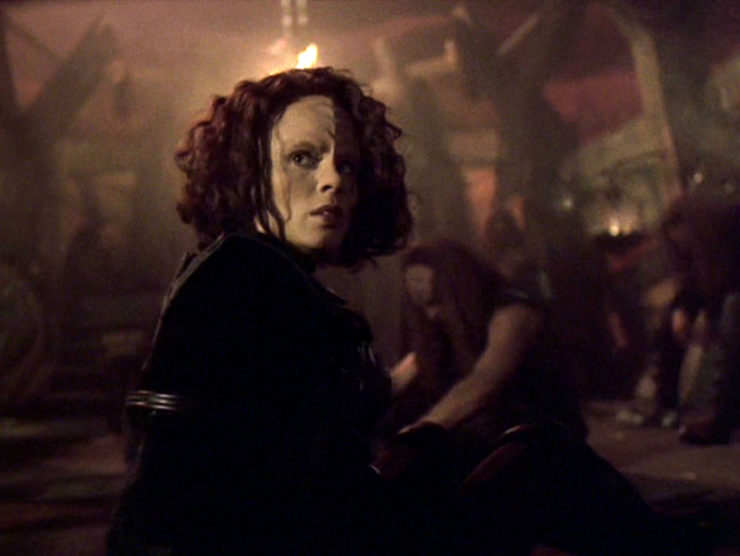“Barge of the Dead”
Written by Ronald D. Moore & Bryan Fuller
Directed by Mike Vejar
Season 6, Episode 3
Production episode 223
Original air date: October 6, 1999
Stardate: unknown
Captain’s log. Torres is coming in hot in a shuttlecraft that’s been damaged by an ion storm. She went out to retrieve their multispatial probe before it got hit by the storm. She manages to crash land in the shuttlebay and is taken to sickbay with a bad concussion.
Chakotay comes to her cabin with a piece of metal that’s about a hundred years old or so with the Klingon emblem on it. Apparently it collided with her shuttle when the deflectors went down, and it means that there was a Klingon presence in the Delta Quadrant some time in the past. Or, as Torres tartly points out, the Borg assimilated a Klingon ship in the Alpha Quadrant and dropped a piece of debris on the way back home.
Later, Torres sees blood coming out of the Klingon logo and hears voices speak in Klingon. She drags Kim into engineering to perform every possible test on it until three in the morning. Neelix interrupts by saying he’s holding a celebration in honor of this great discovery of Klingon archeology. Torres is less than enthused. (What Neelix is doing up at that hour is never explained.)
She meets with Tuvok for her meditation session, and Tuvok is much nastier and more critical than usual, and then he attacks her with a bat’leth and accuses her of dishonor.

Neelix holds the party in the mess hall with lots of bloodwine and replicated gagh and other good stuff. While Janeway is giving a toast, time seems to slow down for Torres; the lights dim, and then a Klingon appears and kills the entire crew in front of her.
Then she finds herself on a boat: the Barge of the Dead, which sails across the River of Blood to bring the dishonored dead to Gre’thor. Torres is appalled to be told that she’s dead, though the shipmaster Kortar—the first Klingon, who killed the gods and was punished by being forced to ferry the dishonored dead across the River of Blood—tells her that he’s seen her once before when she was a child. She drowned, but was revived by her mother.
Another dishonored dead person boards the barge: it’s Torres’s mother Miral.
Then Torres wakes up in sickbay. Turns out her shuttlecraft was indeed damaged by an ion storm, but was adrift, and had to be tractored in. They found Torres comatose, and she only just now woke up from it.
However, Torres remains troubled by what happened while she was in the coma. She never used to believe in the Klingon myths Miral taught her when she was a child, but now she’s sorta-kinda experienced the afterlife. And now she thinks her mother might be dead and being sent to Klingon hell because the sins of the daughter are visited on the mother. Because Torres has been a pretty bad Klingon overall, Miral will have to suffer the torments of Gre’thor.
Torres wants to go back, to have the EMH re-create her near-death experience so that she can go back to the Barge and redeem Miral’s soul so she can go to Sto-Vo-Kor. She talks Janeway into letting her do it via a freedom-of-religion argument.

The EMH re-creates the atmospheric conditions of the ion storm and the shuttlecraft inside a force field in sickbay, which puts her into a coma. She finds herself back on the Barge, and tries to redeem Miral’s soul. Kortar dismisses her attempt, saying that she’s trying to use technology and trickery, because she isn’t really dead yet. So she commits to the bit, as it were, and accepts death and goes to Gre’thor in Miral’s place.
And then she winds up in Gre’thor itself—which is Voyager. She’s surrounded by versions of the crew who torment her. When Tuvok tries to attack her again, she rejects the entire thing, and finds herself back on the Barge—with Miral. Confused—she thought she freed Miral’s soul to Sto-Vo-Kor—Torres asks how to get out of this, finally realizing that she needs to stop fighting. She throws her bat’leth into the River of Blood, saying she’s tired of fighting all the time. Miral tells her that it’s the first step on her journey. She promises her daughter that she’ll see her again—in Sto-Vo-Kor, or perhaps when she gets home.
Torres finally wakes up in sickbay—to the relief of the EMH, Janeway, and Paris, whose attempts to revive her have all failed—and Torres immediately hugs Janeway.
Can’t we just reverse the polarity? Apparently, if you’re put in a coma from an ion storm, you go to the afterlife your mother’s culture believes in. Sure.
There’s coffee in that nebula! Janeway is convinced by Torres to be allowed to go into a coma, er, somehow. Also when Torres wakes up, she says, “Mother?” and then hugs Janeway, because she’s totally her space mom!
Mr. Vulcan. Tuvok is apparently still doing meditation sessions with Torres, as she hallucinates one, albeit one that goes very differently from the usual. (Tim Russ plays this scene more like the Klingon he played in DS9’s “Invasive Procedures.”)
Half and half. Torres first discusses her near-death experience with Chakotay, who advises her to slow her roll and take the time to interpret the vision. This is the same advice Chakotay gave Neelix in “Mortal Coil,” and he didn’t listen, either.

Everybody comes to Neelix’s. We never see the real Neelix, but one of the hallucinatory Neelixes serves as Torres’ tour guide aboard the Gre’thor version of Voyager, which is its own kind of hell. Another one reminds Torres that many great discoveries of the Klingon Empire happened by accident: for example, Sarpek the Fearless found the Knife of Kirrom when he was out looking for his lost targ…
Forever an ensign. A hallucinatory Kim is dragooned by Torres to study the Klingon metal fragment until three in the morning. He is not thrilled at the notion.
Please state the nature of the medical emergency. The EMH grows ever-more frustrated when everything he tries to revive Torres fails.
Resistance is futile. Because the producers apparently will never pass up an excuse to have Jeri Ryan and Robert Picardo sing duets, we get Seven and the EMH singing a Klingon drinking song, twice.
Do it.
“What do you want?”
“Who are you asking?”
“You! Kahless! The tooth fairy! Anybody who will tell me what I’m supposed to do!”
–Torres and Miral discussing philosophy and personal growth.

Welcome aboard. The great Eric Pierpoint plays his third of six Trek roles as Kortar, having played Voval in TNG’s “Liaisons” and Captain Sanders in DS9’s “For the Uniform.” He’ll have two roles in Enterprise, Shiraht in “Rogue Planet” and the recurring role of Harris in that show’s fourth season.
Karen Austin plays Miral; she was one of the finalists for the role of Janeway, and also played a doctor in DS9’s “Nor the Battle to the Strong.” Sherman Augustus and John Kenton Shull play various Klingons.
Trivial matters: This was a reworking of Ronald D. Moore’s original premise for “Soldiers of the Empire,” in which the Rotarran would go to the Klingon afterlife and Worf would see his father.
Gre’thor was established as the Klingon afterlife for the dishonored dead in TNG‘s “Devil’s Due.” Sto-Vo-Kor was established as the Klingon afterlife for the honored dead in TNG’s “Rightful Heir.”
That the Klingons killed their gods was established in DS9’s “Homefront.” Your humble rewatcher told a version of Kortar and his mate, Baka, killing the gods in The Klingon Art of War. Another version of the death of the gods was part of the wedding ceremony in DS9’s “You are Cordially Invited…”
This is the only mention of the Paq’batlh, though this could also be the sacred texts mentioned in TNG’s “Rightful Heir.”
The song that the EMH and Seven sing in Torres’s hallucination of the mess hall celebration is the same song that Worf and Huraga sang in DS9’s “The Way of the Warrior.”
The EMH tries cordrazine to revive Torres, a powerful stimulant first seen in the original series’ “The City on the Edge of Forever.”
Torres started doing meditation sessions with Tuvok in “Juggernaut.”
When Torres and Paris have a child in “Endgame,” she will be named Miral after Torres’s mother.
After Voyager returns home in “Endgame,” Torres spent a great deal of time in the novels Homecoming, The Farther Shore, Old Wounds, and Enemy of My Enemy, all by Christie Golden, seeking out her mother, finally finding Miral on Boreth, where she then died.
Just as Mark Lenard was cast as Spock’s father despite being only seven years older than Leonard Nimoy, and Cecily Adams cast as Quark’s mother despite being nine years younger than Armin Shimerman, Karen Austin was cast as Torres’ mother despite being only four years older than Roxann Dawson.

Set a course for home. “I don’t consider Voyager hell.” This could’ve been a great episode. The beginning and the end are excellent, a good character study of Torres, a nice progression of her character following the self-harm and depression of “Extreme Risk” and the anger-management problems in “Juggernaut.”
The problem is the bit in the middle. Star Trek has always come down on the rationalist side of things. Things that may have seemed supernatural have always, in the end, had some kind of scientific basis, whether the Prophets/wormhole aliens on DS9, the “magic” of Sylvia and Korob in the original series’ “Catspaw,” or the machinations of the red angel in Discovery’s second season. Visions and odd experiences and dreams have been experiences to be interpreted (“Birthright, Part I,” “Rightful Heir,” “Emissary,” “The Circle,” “Basics, Part I,” “The Fight,” etc.), and there’s never been any indication that supernatural phenomena exist.
Until this episode, where we’re explicitly told that there’s a Klingon afterlife. It makes no sense, otherwise, none, that Torres would have so linear and specific an experience both times she gets rendered comatose by an ion storm while in a shuttlecraft.
The last time the show dealt with the afterlife, it was a much more effective meditation on life after death, with Neelix being mostly dead instead of all dead in “Mortal Coil.” This one falls down because it’s not really about the Klingon afterlife, it’s about Torres letting go of her anger and longing for her mother—yet it does so in a way that explicitly states that the Klingon afterlife is real, and that just cuts off the air supply to my disbelief.
And the easy way around this, of course, is to have the whole thing be what Torres experiences while comatose with no interruptions. You can still use the rest of the cast in the hallucination, especially since we have that lovely notion that Voyager is also her own hell. There’s a lot to unpack there, and that’s a much more interesting theme to explore than to have Torres temporarily become an orthodox Klingon in order to justify going back into a near-death coma on purpose. Just keep her in the damn near-death experience the whole time, and have her come out of it when she has the catharsis with the image of her mother. You still could’ve done the character development without establishing that in the Star Trek universe, you can go to the specific afterlife of one of your parents’ cultural heritage just by waving some technobabble about.
Warp factor rating: 4
Keith R.A. DeCandido has written a ton of Star Trek work focused on Klingons, including the novels Diplomatic Implausibility, The Art of the Impossible, A Good Day to Die, Honor Bound, Enemy Territory, and A Burning House; the novella Enterprises of Great Pitch and Moment (part of the Slings and Arrows miniseries); the short stories “loDnI’pu’ vavpu’ je” (in Tales from the Captain’s Table), “Family Matters” (in Mirror Universe: Shards and Shadows), and “The Unhappy Ones” (in Seven Deadly Sins); the comic book Alien Spotlight: Klingons; and the reference work The Klingon Art of War. He also contributed to the Star Trek Adventures Klingon Empire Core Rulebook.










